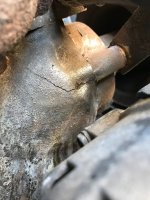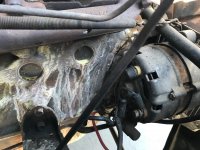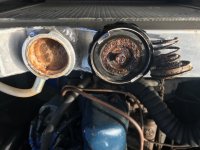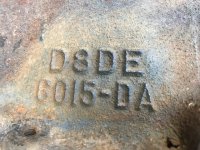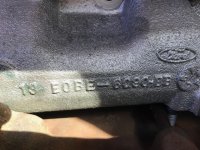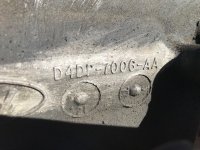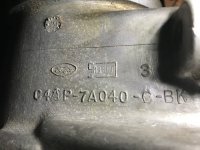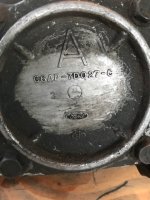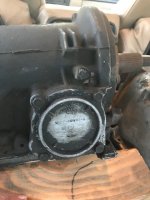Greetings all,I've been visiting this site for a few years now, posting only when I really need help- kinda like Homer Simpson praying to the Almighty only when he's really in trouble.
It's time I provide the whole story. Cuz I'm in trouble. Pull up a chair. Get a cold, or hot, beverage.
I live in Southern California. I paid $15 for my first car in 1969 in Chicago- '62 Falcon, 4 door, straight six Futura, don"t remember which displacement. It had a black exterior with a white, spongy vinyl roof, red bucket seats with a chrome center console AND stock 4 speed manual!!! Maybe it was a two-door? Major body rust from Chicago winters. It was so bad that when I'd drive in a snowstorm the snow would blow up through the holes in the passenger floor, much to the chagrin of my girlfriend. Got a picture somewhere of it, gotta find it.
So it was quite a thrill when, 10 years ago, I had the chance to buy a beat up '65 Ranchero 200, C4. It was a mess when I bought it for $500 from the 2nd owner who had it parked in his driveway, idle, in Los Angeles for a couple years, and had done nothing to it after buying it from the original owner who had also done little maintenance on it. I've have slowly been restoring it as time and money allowed.
Before I'd learned of this site I had the engine rebuilt in 2011 by an unknown mechanic who was referred to me by a friend. Over the years I've replaced most of the window and door seals, flushed and repaired the gas tank and radiator, replaced the wheel bearings, brake cylinders, pads, drums, master cylinder, tie rods, center link, idler arm, engine mounts, starter, exhaust, etc, etc. Couple years ago I bought an Autolite 1101 off ebay and installed it with a DSII (after persistent problems with the 1100 and several Pertronix failures).
Last week my block cracked. How that happened is a good, hard lesson learned which I'll briefly share so others don't make same mistake.
16 months ago I bought a new aluminum radiator and thoroughly flushed the engine before installing. However this is where I think I made the first of several mistakes. I mixed the antifreeze with tap water. Didn't use distilled water. Didn't know I should. Very embarrassing.
Then came the next mistake- life intervened and I went out of state for 4 months and the car sat unused until this past December when I took it to a great carb shop, which I highly recommend, here in Oxnard, CA, Pacific Carburetor. In two hours Jeff and Bill had my baby running like I'd always dreamed. So freaking cool! It was running so good that I decided to drive it the 60 highway miles to work the next day. Mistake #3- didn't check the radiator before I did. If I had, I would have found the dark brown, rusty gunk and corrosion that had built up during those 4 idle months and was lurking throughout the cooling system.
The weird thing was that during the commute the next morning, the temp gauge remained right where is always does, nice and cool, for 59.5 miles... until I slowed down at the exit ramp. I saw right away the needle start to rise but thought I could make it the half mile to work, obviously another mistake. I got to work, it was steaming slightly, shut it off and went inside.
At lunch I went out and opened the radiator cap to find that the spring under the cap was so corroded it separated from the cap and the brown gunk covered the inside of radiator. I was horrified of course, but didn't learn of the cracked block until the next day. I felt pretty stupid.
When I cleaned and brushed the block at the crack I found that it appears to be about a one-inch fissure originating from where the water pump/alternator bracket bolt enters the block (I hope to provide pix below) which suggests that bolt was over tightened at some point- another mistake. I don't remember ever replacing the water pump, but I believe I have replaced the alternator and probably am responsible for the over tightened bolt years ago. Jeez.
I'd appreciate any thoughts on any of the above events. Please be kind. I'm a bit fragile at the moment.
I started searching for another '65 block and found one. But then, as I was searching for a Large Log head I found a guy with a '78 200 block, head, and C4 transmission. Hmmm... interesting! He doesn't know anything about the parts other than they were in a dead '65 Ranchero, and that the cylinders are standard bore. I'll check the casting numbers before I commit, but I'm willing to take a chance and buy the package (very reasonably priced) as long as I don't run into formidable fitment problems later... thus the reason for my initial post. Thanks to Bubba's earlier response, it sounds like it should fit.
So now I feel like I'm at the crossroads. And would appreciate your thoughts. I intend to rebuild, but by how much? My intentions for the car is a mild performance upgrade ride, daily/weekend driver. A reliable, fun ride that realizes the potential of our beloved I-6. But I won't be going to the strip. Too much power will just get this geezer in trouble. Trust me.
I'm currently living in a condo and won't have a garage for another 8-12 months. And a lot of the rebuild is out of my mechanical experience anyhow, so I'm hoping to partner with a patient mechanic that will allow me to participate/observe in order to learn. I'd also want him to communicate/supervise with the machinist work which is one of my greatest anxieties. I'm thinking I could provide the VI parts and do the machine shop runs, etc. to keep costs down.
I've read/reread most of the fabulous "tech archive" articles on this site and read/re-read the essential Handbook so many times that almost every other line is highlighted and the pages are beginning to fray. As long as I'll be undertaking a rebuild, it certainly seems obvious to address the deficiencies of the '65 small log head and look also for a large log head. But as long as I'll be rebuilding the head... what about a three-angle valve job, upgraded valves, springs, lifters, cam, cam bearings, main bearings, ARP Studs, dual roller timing chain...??? I'd also love to upgrade to one of the Weber 2vs, either the 32/36 DGV or the 38/38 DGS. Undecided. I know the Handbook highly recommends the DGV, but my guys at Pacific Carburetor love and recommend the DGS. At the moment I'm favoring the progressive DGV.
I've also done the $ math, which is... daunting. My VI parts shopping list alone is up to $2k to do it right and that's without machining, mechanic labor costs plus whatever else I'm overlooking. I want to rebuild the large log head for reliable, increased performance but don't have unlimited funds. I would appreciate your thoughts on where I can trim the large log rebuild budget, if possible. BTW- I've pushed a planned headers purchase/install until after the rebuild
Sorry for the long post, but I wanted to convey the full picture. I'll be needing advice along the way for sure. Thanks

